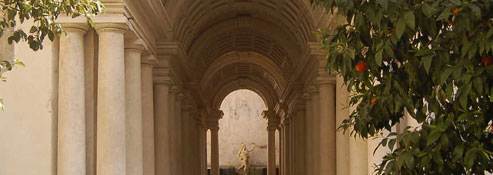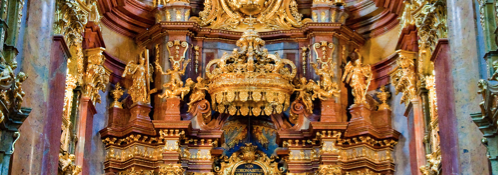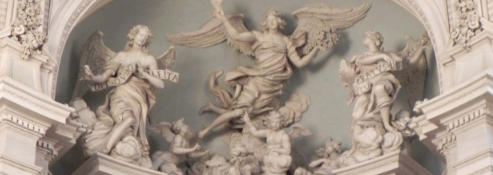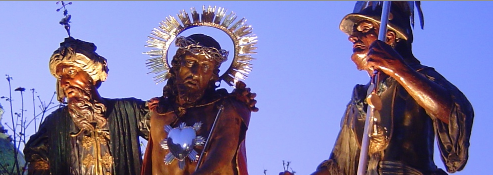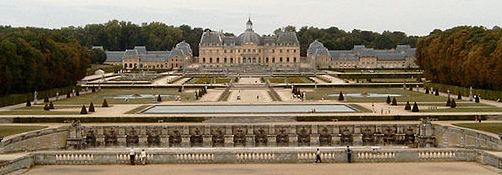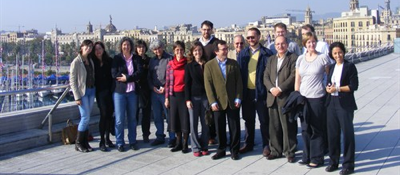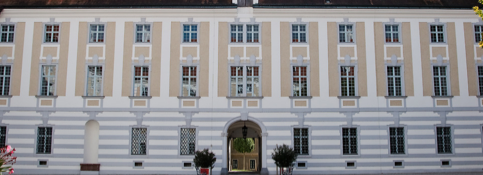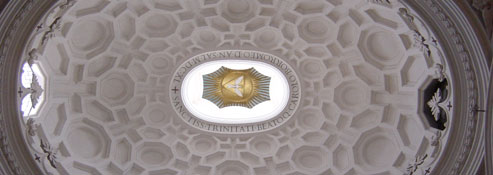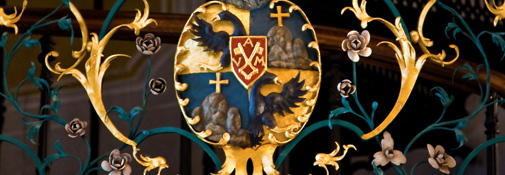1. "Relação de todos os livros pertencentes à livraria que tem o Exmo Senhor General D. Luís António de Sousa nesta cidade de São Paulo em o ano de 1775". [Relation of all books belonging to the library that his Excellency General D. Luís António de Sousa has in the town of São Paulo in the year of 1775]: Manuscript cover and second folio. © PT/SICM/SSC 06.02/SUBSI-GSPSSC/01.01/g.1748.05, Mateus Archive.

Introduction
Research of a reader's profile in order to draft a history of the book and its readings, often resources to private libraries despite the challenges such sources represent in these studies. [1] Such challenge are related with the absence of information primarily derived from the lack of information regarding documents from the epoch as inventories, wills or even purchase receipts that can determine the existence of a given book in a determined library. On the other hand, the existence of a private library is not a determinant factor as characterizing a good reader once the book was regarded as a luxury object, far from the popular groups to possess. However, being the owner of a private library indicates an interest in cultivating the mind apart from being associated with the labors of a career.
Therefore, we consider the study of a library, whether private or public, should take into account not only the analysis of its contents - books - but also the biographic profile of its owner (or collector) whose contribute is decisive in the choice for a certain book. Consequently, this paper focuses in analyzing the private library in the Mateus Palace and in particular The Don Luís António de Sousa Botelho Mourão (1722-1798) books' collection, which emerged from my ongoing PhD research [2] about manor houses in Douro's region, in the Eighteenth century, when I was confronted with the existence of a library in the Mateus Palace (in Vila Real, Portugal) that had not been studied so far. This is a significant fact because this palace is one of the most representative exemplars of Portuguese Baroque civil architecture. For this reason, research in the palace's archive was carried out with the objective of finding some of its inventories. However, it was only discovered one document entitled "Relação de todos os livros pertencentes à livraria que tem o Exmo. Senhor General D. Luís António de Sousa nesta cidade de São Paulo em o ano de 1775" ["Relation of all books belonging to the library that his Excellency General D. Luís António de Sousa has in the town of São Paulo in the year of 1775"]. [3] Despite this title, our paper will focus not only in the books that were in Brazil's library, but also the ones that are in Mateus Palace's library.
To develop this study, the research was organized in several phases: the transcription of the Don Luis inventory; the books' identification (its author, title and language); confirming the presence of those books in the Mateus Palace's library [4]; and, analyze the main languages, themes, formats and value of Don Luis's books.
The paper begins with some short notes regarding the Mateus Palace followed by a description of the Library as a significant unit of privileged knowledge of the Mateus Lords and for which the figure of Don Luís was central hence we also focus on his relevant biographic data for the study of his library. We will also focus our attention on Don Luis' library from the transcription and data analysis which would not be complete without conferring the current data available at the Mateus Palace Library. This interpretative reading reveals a set of books from the Relação […] manuscript categorized according to the main languages, themes, formats and dates of this library.
In conclusion, we intend to establish a relation between Don Luís António's biography and his books, to obtain some conclusions about the owner's personal and professional influence over his own library while relating this library with other private libraries that illustrate the elites' knowledge due to the corpus of books available in the sense of reflecting the Portuguese Eighteenth century social, political and cultural contexts.
The Mateus Palace: history and art [5]
2. Mateus Palace. Main façade. 18th century. Mateus, Vila Real (Portugal) © Ana Celeste Glória

The Mateus Palace is located in the north of Portugal (Vila Real) and it was constructed during the first half of the Eighteenth century by Don António José Botelho Mourão (1688-1742), 3.º Morgado de Mateus and Cumieira's heir, and the father of Don Luís António.
3. Mateus Palace plains, upper and ground plain. From Dom José Maria de Sousa Botelho Mourão; Vasconcelos's inventories. [1800] © PT/SICM/SSC 06.02/SUBSI-GSPSSC/01.01/g.1748.05, Mateus Archive.

Don António replaced the former family house that had stood on the site since the beginning of the previous century by a palace in which the decorative and architectural elements can be situated in the baroque frame. Those elements are mostly present in the main façade, in the curvaceous entablatures, pediments, pinnacles and statuary, revealing a splendor and opulence that is an example of the baroque art. Also, in the architectural plan design, in "U" shape which marks distinctively the house's architecture by giving it monumentality, regularity and symmetry. These elements reflect an Italian baroque influence that allowed associating the house's architectural authorship to the Italian artist Nicolau Nasoni (1691-1773) [6], as the responsible artist of Mateus Palace. On the other hand, the coherent style and similarity to his other works also contributed to this statement. [7]
4. Nicolau Nasoni (1691-1773). Portrait. Unknown author, c.1770. Clérigos tower.

The building, similar to others of its specificity has two levels. The ground level was reserved to the service facilities (as granaries, stables, cellar and others), and it was conceived in complete subordination to the second level, known as noble floor. In this level, the Entrance Hall defines the palace centre/symmetry and provides access northwards to the Library and the wing housing the bedrooms, and south to the Sala do Tijolo and the wing accommodating the reception rooms.
The palace's interior is adorned with decorative objects (furniture, paintings, tapestries, wares, gold and silver pieces, for example) that reflect the palace's eighteenth century ambience of abundance and comfort.
5. Reception room and living room © A. RIBEIRO, The Casa de Mateus: guide, Vila Real 2010, p.40; and V. G. MOURA, Figuras em Mateus, Lisboa 2002, p.150

To complete the architectural plans for this palace, and contributing to its impressive magnificence, we can also find next to the house the private Chapel, the gardens and large terrains that constitutes the palace's previous farm.
The palace's monumentality and splendor reflect the decorative and architectural care of its owners to enrich their house, but also, its economic, social, politic and cultural power as the following brief analysis of the library is exemplary.
The Mateus Palace's library
6. Library overview © Mateus Foundation

The library is located in the noble floor and houses a remarkable collection of antique books, in a total of 459 (four hundred and fifty nine books) published between the 1500's and 1800's [8], reflecting two particular aspects of the house's history. On one hand, the family's concern to keep its vast heritage: achieved by the strategic alliances and marriages between northern noble families- this was related to a process of assets' binding hence ensuring the family's heritage transmission (properties, objects and others). On the other hand, their gradual social up scaling throughout the seventeenth and eighteenth centuries, from a family of rural nobility to court nobility with high career positions consistent with their statute therefore which allowing them the enhancement of their heritage. [9] These aspects relate directly with the acquisition of proprieties and even the acquisition of books for the library.
The space currently used as the Library was ordered to construct by Don António however we cannot acknowledge if at the time it was intended for such a purpose once there is no reference to it. According to the information granted by the Mateus Foundation [10], the libraries that existed in the Manor at this time were private or individual hence managed by the tastes of individual family members and then passed on o future generations. Therefore, the keeping of the books would very likely be sustained by its owners and maintained in trunks.
In fact, the concept of a family library at the Mateus Palace only begun in the end of the second half of the 19th century after the death of Don José Maria de Sousa Botelho Mourão e Vasconcelos (1758-1825), son of Don Luís António, corresponding to the date his private library is incorporated in the Mateus' Library.
In order to cast some light concerning the library's history and its content, some research was conducted to find some of the library's inventories or similar documents. Although no document was found and in the library research catalogue there is not a book owned by Dom António, one of the houses' first proprietors, and only books from other family members were found Despite these considerations, we must keep in mind that this does not mean that Don António did not own a library, once his books may have been lost. Actually there are some books in the Mateus Library whose owners were never identified once they only have an ex-libris from Casa de Mateus. On the other hand, during the research it was found what it seemed to be the only existent Mateus Palace's library inventory, which is related to Don António's son, Don Luís António de Sousa Botelho Mourão. The importance of this document to the Mateus Library history is corroborated by the recent publication of the Library Catalogue [11] that confirms the inexistence of inventories.
During the catalogue and documentation work, the Mateus Foundation, responsible for the Palace's management identified an extended list of book's owners [12]. However, we stress out the name of Don Luís António due to the existence of the mentioned inventory that allows making a reconstitution of his collection and consequently, his tastes. Besides after the inventory transcription, we came across that the number of books that were mentioned in the Relation of all book's […], was superior from those ones that are identified, in a total of 37, with ownership's notes in the Mateus Library. However, we should point out the existence of a large number of books, with the Casa de Mateus ex-libris, and that we believe to have belonged to several family members, and possibly to Don Luís António.
At this point it becomes of crucial significance a brief analysis about Don Luís António biography to understand some of the libraries choices.
Don Luís António de Sousa Botelho Mourão (1722-1798) [13]
Don Luís de Sousa Botelho Mourão, son of Don António José Botelho Mourão (1688-1746) and Lady Joana Maria de Sousa Mascarenhas e Queirós (Lady of Moroleiros), was born February 1722 in his grandparents' property in São Veríssimo de Riba, Amarante (Portugal).
Although Don Luis' education is not documented we can establish that his military career was consolidated by his grandfather, Don Luís António de Sousa (-), governor of São Tiago da Barra's Castel in Viana, with whom he lived until he was 23.
He married with Lady Leonor Ana Luísa Josefa da Portugal (1722-1806), daughter of Don Rodrigo Sousa Coutinho (1755-1812) and Lady Maria Antónia de Meneses (-). From a young age, Don Luis was a military, being promoted to Sergeant in 1735 and Master of Field Support of Oporto in 1749.
7. Don Luís de Sousa Botelho Mourão's portrait. 18th century. Oil on canvas © Mateus Archive. Inv. 463

In 1762, Don Luís António became noticed during the Seven Years War (1756-1763) hence promoted to Infantry Colonel, and in 1765 he was nominated as Governor and General Capitan of San Paulo - Brazil - where he would stay for ten years.
Influenced by the Enlightenment ideals in addition to the political orders from the Regime, Don Luis was responsible for the intricate defense of border lines south of the Portuguese Colony against the Spanish Empire as well as for the economical recuperation of the area, introducing new and modern administrative principles as well as public and economical ideals. His actions were determinant for the region's growth militarily and economically, socially, politically and even urban. Therefore he is, today, one of San Paulo's historically acknowledged personas.
It is, considering this prominent political and military career in Brazil, that we are analyzing his library. The books acquired throughout his life regardless of its dates or geographies, are directed at consolidating and deepening his career and his culture as a literate and noble man. Nevertheless, only a detailed analysis of the Relation of all book's… … will reveal more about the Don Luis Library.
The Don Luís António Library
8. "Relação de todos os livros …". Manuscript chover © PT/SICM/SSC 06.02/SUBSI-GSPSSC/01.01/g.1748.05, Mateus Archive.

In the Mateus Palace's archive, where the research was centered, we came across with a hand-written manuscript comprising a small inventory concerning Don Luis' Library. The document, entitled "Relação de todos os livros pertencentes à livraria que tem o Exmo Senhor General D. Luís António de Sousa nesta cidade de São Paulo em o ano de 1775" ["Relation of all books belonging to the library that his Excellency General D. Luís António de Sousa has in the town of São Paulo in the year of 1775"], is in fact, a list of books that Don Luís António owned in San Paulo (Brazil) up until 1775 - the same year he resigned his position as Civil Governor and returned to Lisbon.
As this paper's objective is to examine the Don Luís António library, we will address the following topics: what books were in the Don Luís António Library? Which were the dominant themes, languages, chronologies and formats? How were these books ordered and displaced? And finally, what was the symbolic but also financial value of this collection? These questions will be answered by the follow Relation of all book's… analysis.
The structure and content of Don Luís António inventory is organized in the follow six sections [14] :
- «Relation of Books that His Excellency brought from the Kingdom […]» (f. 3-4; in a total of 38 books);
- «Books that came to His Excellency from Lisbon when he was governing in the City of S. Paulo […]» (f. 4v.-5; in a total of 12 books);
- «Books His Excellency had in S. Paulo […]» (f. 5-6; in a total of 22 books);
- «Books which belong to Andre Mz.o […]» (unknown figure) (f. 6; in a total of 3 books);
- «More books existent in S. Paulo […]» (f.6-7; in a total of 3 books);
- «More books which His Excellency bought in S. Paulo […]» (f. 7-8v.; in a total of 56 books).
9. Folio's detail (f. 3) © PT/SICM/SSC 06.02/SUBSI-GSPSSC/01.01/g.1748.05, Mateus Archive.

From this inventory we can account for a total of 134 volumes from which it is particularly relevant the fact that almost half of this collection was acquired during Don Luis' stay in San Paulo. Also, and according to this tabulation, we can conclude that the criterion that was devised to organize the collection was focused in two aspects: the identification of provenience of the books in terms of distinguishing between those that came from Portugal and those that were acquired in Brazil. Therefore, firstly the books that came from Lisbon were logged in; secondly, those that were bought in Lisbon while Don Luis' residency in Brazil; then the books that were already in the Jesuit Library in San Paulo [15] followed by those that belonged to «Andre Mz.o […]» (unknown) and finally, the books that were acquired in that same city. This record is quite straightforward supporting the thesis that this may be a list prepared for the return voyage to Lisbon.
(one volume of Henrique Catharino)
(two volumes of Geografy of Medrando in 8.º)
10. Book's description. Folio's details (f.3v) © PT/SICM/SSC 06.02/SUBSI-GSPSSC/01.01/g.1748.05, Mateus Archive.

The type of registry is so uncomplicatedness that actually obscures the identification [16] of most books once it is common not to refer the author or title of each book. For example, the first registry, «Hum tomo de Henrique Catherino [...] 1» (fl.3) refers to one single volume (possible) authorship of Henrique Catarino without mentioning the exact title. [17] Furthermore, most references to the titles are abbreviated such as «Dous tomos de Geografia de Medrando em 8.º [...]» (fl.3) - which refers to Sebastian Fernandéz de Medrano's (1646-1705) publication, Geographia o moderna descripcion del mundo (Amberes: por Henrico y Cornelio Verdussen, 1709) that can be found in Mateus Palace's library. [18]
Other data occasionally introduced in the registry are language and format of the books. However, and once more, not always these two references are logged in which signifies that book identification can become quite complex and often, impossible, especially when combined with the above mentioned absent information. For that reason most books are registered with the information of "no title identified" as presented in the transcribed document (in attachment). With the absence of this referential information, the already mentioned thesis that this manuscript was a compilation of books transported from Brazil to Portugal is reinforced.
In the Relation of all book's […] we could identify 134 volumes from which 47 are currently in the Palace's Library [19]; 32 that, although properly identified are not in the mentioned library; and 54 volumes that could not be identified due to the absence of information concerning authorship and/or full title.
From these 134 volumes that are logged in the Relation of all book's…, we recognize some specificities such as personal diaries (3), drawings (7), maps (1 volume), catalogues of engravings (3 volumes) and other hand-written documents (3).
From these data we also analyzed the dominant idiom, thematic and formats, particularly from those books that was possible to identify [20] and found or not in the Mateus Library. Hence, when information was scarce or even inexistent, we preferred to refer the books as "Unknown" or "Unknown Title".
Therefore, focusing the analyses on these issues, we could conclude that on the linguistic domain (Table I), the Don Luis library was not up to date with its epoch and tendencies once French was not the dominant language. Consequently, as observed in Table I, we encountered a linguistic adequacy to the geographical areas were the military official carried out his duties - being then, Portuguese the overpowering language (52 books).
There were also several books that we could not establish the language (45), others were in Latin (22) as well as Spanish (8) and evidently, French (7). However, we must highlight that being this an ongoing research these figures may substantially vary once all books are identified.
Table 1 - Linguistic domain
| Languages | Titles | % |
| Portuguese | 52 | 39 |
| Unknown | 45 | 34 |
| Latin | 22 | 16 |
| Spanish | 8 | 6 |
| French | 7 | 5 |
| TOTAL | 134 | 100 |
TABLE 2 - Themes domain
| Themes | Titles | % |
| Literature | 32 | 24 |
| Others | 30 | 22 |
| Sciences and arts | 28 | 21 |
| History | 24 | 18 |
| Theology | 10 | 7,5 |
| Jurisprudence | 10 | 7,5 |
| TOTAL | 134 | 100 |
Concerning the dominant themes of the library (Table II), we have grouped them in six categories [21] without establishing other sections or subsections due to the dimension of the corpus. These categories are: Theology [22], Jurisprudence [23], History [24], Sciences and Arts [25] and Literature [26] and Others (that are unknown).
Therefore, the 134 titles in the Relation of all book's […] are distributed as following: 32 in Literature (24%), 30 as Others (22%), 28 in Sciences and Arts (21%), 24 in History (18%), 10 in Theology (7,5%) and 10 in Jurisprudence (7,5%). These classifications allowed us to determine that Don Luis revealed particular interests mainly in Literature and Sciences and Arts.
11. Front Cover. VIRGILIO, Aeneis. Venetiis, Apud Natalem Feltrini, 1713 © BIB 444, Mateus Library.

For instance, in the category of Literature one finds several classical authors such as Livy, Ovid, Virgil, Seneca, The Younger, among others [27], which underlines the importance of cultural, social, economic and politic references from classical civilizations.
On the other hand, Sciences and Arts overall a more diversified range of disciplines with again, an underling of military books such as the work of Luís Mendes de Vasconcelos (1542-1623), Arte militar (1612); of José Cassani (1673-1750), Escuela militar de fortificacion ofensiva y defensiva (ed. 1705); and the French books of Henri-François de Bombelles (1681-1760), Tratado das evoluçoens militares […] (unknown edition); and Alain Manesson-Mallet (1630-1706), Les travaux de mars ou l'art de la guerre (ed. 1684-1685) [28] - to name some. These also underline Don Luís António's desire to achieve and strengthen military knowledge never consolidated in specific training or education.
In this last category, apart from the treaties of Arithmetic and Algebra as well as Nautical treaties, we could not help but notice the existence of Vitruvio's book De architectura libri decem (ed.1543) [29] which was common in most libraries ranging from small to influential elites.
12. Front cover and fl.116-117. VITRUVIO, De architectura libri decem. Argentorati, in officina Knoblochiana per Georgium Machæropioeum, 1543 © BIB 449, Mateus Library.

Still in the Sciences and Arts category although not necessarily belonging to Don Luis, in the Mateus Palace's Library we can also find Sebastian Fernández de Medrano's (1646-1705) book, El architecto perfecto en arte militar (ed. 1700) [30], as well as Jacques-François Blondel's (1705-1774), Cours d'architecture ou Traité de la decoration (1771-1777), with the correspondent engravings (1771-1773) [31], that may have belonged to Don Luís Antonio's library.
Finally, we must mention the presence of some religious books that demonstrates Don Luís António sacred devotion, but more specific his intimate and personal conduct. In fact, it was Don Luís António who completed the Chapel in 1750 [32], and spent his last years of life dedicated to the administration of his properties and in religious devotion. According to the author Heloísa Belloto [33], he exercised his devotion and faith in an almost unhealthy manner focused in obtaining indulgences, and a fanatic purchase of relics of all sizes and shapes.
13. Front Cover. Vulgata - Sacra biblia. Parisiis : apud Franciscum Coustelier, 1664 © BIB 441 Mateus Library.

Concerning the editions' chronologies, we could not at this point, advance with the research once there was not sufficient or relevant information. This same issue addresses the Library's value once no receipts or other information was retrieved concerning the book's acquisition. Additionally, as 54 books remain unidentified, the estimative of the collection's value would quite certainly, be incorrect.
In relation to the spatial distribution and organization of the Don Luis' library in San Paulo, no registry or documentation could be found, not even in the Mateus Palace.
However, in terms of conservation and restoration of the library we could establish that D. Leonor (D. Luis' wife), in 1773, proceeded with the conservation of the bookshelves [34] and maintenance of the books - fact that she informed to her husband [35] - which indicates a preoccupation of the house's administrators with the library even though Don Luís António was abroad.
Conclusions
After analyzing the Don Luís António book collection we can conclude the document Relation of all book's […] it is not sufficient to achieve a correct vision of Don Luís António library and not even from the Mateus Palace's collection. However, it drew a general idea of its contents, the languages and themes that were in Don Luís António possession. Although, we believe that this research is a story point for future research with other perspectives.
The professional and personal taste had an extremely influence in the acquisition of books. It is not for an unpretentious motive that we found Sciences and Arts books about military art in this library or even maps or diaries - we found those because Don Luís António was a military official hence he needed those books.
As other private libraries, the Don Luís António library is suited to its owner's profile. For example, Dom Vasco Luís da Gama (1612-1676), 1st Marquis of Nisa and 5th Count of Vidigueira and Unhão, vicery of India, and Portuguese ambassador in Paris, had a priveligious and political position in 17th aristocracy, useful to the acquisition of cultural objects as books. Closer to the Portuguese king John IV, buys for the court several books as for his library. [36]
Or, Don João de Mendonça (1711-1736), Guarda's bishop, responsible for the construction of the gardens of the Castelo Branco's Episcopal Palace, had also a vast library, with 1021 books. The thematic categories that stand out from the library are the Theology, and Sciences and Artes, which had an important influence in the gardens statuary project. [37]
And with a closer profile, Don Luis's library, Don José da Silva Pais (1679-1760) [38], a high rated Military Sargent who, in 1757, owned a 437-book library in which Sciences and Arts and History were detached themes particularly Military Art, Geometry and Mathematics.
In these libraries we can found some of the Don Luís António's books [39], especially in the last one. The presence of such books, testify their importance in the cultural context of the eighteenth century and more particularly in knowledge circulation.
Although we initially intended to research on the Mateus Palace's Library, we refocused our purpose in one single document, the Relation of alls books […] which on the other hand, concerned solely Don Luís.
An analysis about the wide collection of books in the Palace would reshape our study into another one only supported by the twentieth century catalogues and without any documents of the epoch. However, in a nearby future we believe that kind of research will be held as to bring new contributions to the library's knowledge and in particular to promote its specificities.
In fact, Don Luís António's Library was enlarge by the contribution of his son, Don José Maria de Sousa Botelho Mourão e Vasconcelos, who was the responsible for the monumental and illustred edition of the Portuguese famed publication, Os Lusíadas, of Luís de Camões.
Attachment [40]
Transcription of the manuscript "Relação de todos os livros pertencentes à livraria que tem o Exmo Senhor General D. Luís António de Sousa nesta cidade de São Paulo em o ano de 1775".
Relation of all books belonging to the library that his Excellency General D. Luís António de Sousa has in the town of São Paulo in the year of 1775
[fl. 1]
N.º 4 e N.º 5
Rellacam de todos os livros pertencentes a livraria que tem o Ex.mo Snr.' General D. Luís Antonio de Souza nesta cidade de S. Paulo em o anno de 1775.
Relation of all books belonging to the library that his Excellency General D. Luís António de Sousa has in the town of São Paulo in the year of 1775.
[fl.2]
Livros
Books
Tres livros do diário da Derrota desde q S Ex.a Sahio de Lx.a de 23 de Fever.o de 1769 e toda mais em de ofi… em borroens nos maços Seg.tes
Sete maços de borroens de derrota
[fl. 2]
Rellaçao' dos Livros q.' S. Ex.a trouce do Reyno
Relation of Books that His Excellency brought from the Kingdom
Hum tomo de Henrique Catherino
Dous tomos da Vida de Riperde
Hum tomo grande de Tacido traduzido
Nove tomos da Vida de Luis 14
Hum tomo pequeno de Tacito Latino
Hum tomo de Eclogas de Virgilio em Frances
Hum tomo de Virgilio latino
Tres tomo de Oracio do P.e Sanadon
Hum tomo de Ovidio
Duo tomos de Cartay do P.e Vieira
Tres tomos de Arte Maria
Sete tomos de Arte da Guerra de Fularem folio 7 pequeno
Hum Tomo de Espirito de Tularem em quarto
Hum tomo de Cronica de El Rey D. Joao' o pr.º em folio
Hum tomo de El D. Joao' o Segd.o em quarto
Hum tomo da Chronica de El Rey D. Joao' o terceiro em folio
Hum tomo de Elementos de Geometria em quarto
[fl. 3]
Dous tomos da Escritura Sagrada do Padre Hamel (?) em folio
Dous tomos Escola do mundo de oitavo
Dous tomos das Fabulas de Ovidio
Hum tomo de memorias de Monte Cuchili de 8.º
Dous tomos de Geografia de Medrando em 8.º
Hum tomo de Abrigia da Estorria de França em oitavo
Hum tomo do novo Regulam.to da Cavalaria em oitavo
Hum tomo do Novo Regulam.to da Infantaria em oitavo
Hum tratado de Navegaçao' em quarto
Hum tomo de Mappas Françes de quarto atravecado
Hum tomo de Evolucoens de Bombeles em 8.º
Um tomo de Dom Quixote em folio em francês
Hum tomo de Batalha de El Rey de Pruccia Estampadas de folio atravecado
Hum tomo de Estampas dos mezes do ano em folio atravecado
[fl. 4]
Hum tomo de Estampas Curiozas
Hum Livrinho de oração mental de tira
Hum Livrinho do Officio dos defuntos em tira
Hum tomo Desterro da Epoerezia en oitavo
Dois tomos de Oras do Officio de Nossa a Snr.a em quarto
[fl. 5]
Livros q.' vieraó a vierao' aS. Ex.a de Lisboa achando-ce na Cid.de de S.Paulo Governando
Books that came to His Excellency from Lisbon when he was governing in the City of S. Paulo
Hum tomo de Arte de Guerra em Francês de folio grandeTres tomo das Coleccoens das novas Leyas
Sete tomos com capa de papel pintado em folio, que contem primeira e segunda parte da de
duçao' Cronologica, outra primeira e segunda parte da Deduçao' Cronologica, e tres tomos das provas
Hum tomo Compendio estorico da universid.e de Coimbra em folio
Dous tomos de Petiçao' de Recurço pelo D.r Joze de Seabra com capa de papel pintado em folio
Hum tomo de Congratulaçao' das melhoras do Ex.mo S.r Conde de Oeiras em quarto
Quatro Indeces pertencentes a Segunda parte da Reduçao' Cronologica
Tres tomos piquininhos capas de papel pintado de Cicero sobre as obrigacoens Civês
Hum tomo dos Estatutos do Colegio Real dos Nobres em capa de papel pintado em folio
Hum tomo de Concluzoens de logica com capa de papel pintado em quarto
[fl. 6]
Hum l.º de folio capa de pregsm.º
Colecção das Leys sobre a liberd.e dos Indios do Brasil
Hum maço de Leys (…) enquadernas
Livros q' S Ex.a houve em S. Paulo
Books His Excellency had in S. Paulo
Tres tomos da Ordenaçao' Capa de pasta em quarto
Hum tomo Instrucçao de principiantes q' contem as vidas de nossos Reys em quarto
Hum tomo das obras de Claudio Manoel da Costa em quarto
Hum tomo da Esroria da Jurisprudencia natural em quarto pequeno capa vermelha
Hum tomo da Arte da Lingua Brazilica em oitavo
[fl. 7]
Hum tomo de Divirtim.tos militares em quarto
Hum tomo do tratado da Guerra e da paz em quarto
Hum tomo reflexoens sobre a vaedade dos Homens em quarto
Hum tomo de Cartas de Dom Fran.co Manoel de quarto
Hum tomo = Perfeito contador em quarto
Hum tomo = Tratato de Aritemetica em 4.º
Hum tomo = Curço de Matematica em 8.º
Hum tomo = P.e Simao' Mazeta sobre as missoens do Paraguay em quarto
Hum tomo = Dezenganos p.a medecina em oitavo
Hum Livrinho Coroa Virginia em tira
Hum tomo = sobre a Autoridade Regia em 8.º
Hum tomo = Academia ao S. Joao' de Almada e Mello em quarto
Dous = Cadernos de noticias da Caza Santa
Hum L.º velho manuscrito, q' contem varias obras em verço em 4.º capa de pergaminho
Hum L.º velho Arte de Principes manuscrito de 4.º com capa de pergaminho
[fl. 8]
Hum maço de estampas muito velhas
Hum livrinho muito pequeno = Regula Sancti Benedicti
Livros qe forao' de Andre Mz.o
Books which belong to Andre Mz.o
Hum l.º de folio = Catalogo das Rainhas de Portugal
Dous tomos de folio = Memorias de Braga
hum l.º de folio = Memorias de Malta
Mais l.os havidos em S. Paulo
More books existent in S. Paulo…
Hum l.º de folio Manuscripto = Colecçao de varias Obras feitas a S. Ex.a com capa
amarelaHum maço de Gasetas
Hum l.º de Mercurios
[fl. 9]
[seis títulos repetidos anteriormente, e riscados]
[six titles repeated and scratched]
Mais livros q' S. Ex.comprou em S. Paulo
More books which His Excellency bought in S. Paulo
Seis tomos em Frances = Intitulados Lami des Hommes em oitavo comprados ao Mestre Regio da Gramatica p.r des patacas
Dous tomos de Calepino
Sete tomos de Picas [?]
Quatro tomos de Obras de Ovidio
Dous tomos de Obras de Virgilio
Hum tomo de Arte pratica de Navegar
Hum tomo de Europa portugueza
Hum tomo de Virgilio Comentado
Hum tomo de Trigonometria Requtilinia
Hum tomo de Apologias de D. Franc.co Manoel
[fl. 10]
Dous volumes de Agudezas de Oven
Hum volume de Arquiteture de Vitruvio
Hum volume de Tragedia de Seneca
Hum volume de Sueotonio
Hum volume de Titulivio
Hum volume de Manual Thezaurio
Hum volume Selestis Peregrino
Hum volume Indiculus Universalis
Dous tomos noticias do Brasil
Hum volume Gramatica Anglo Luzitanica
Hum volume Poetarium Flores
Hum volume Guia de Contadores
Hum volume da Estoria Aborbe Condito
Hum volume Satiras de Juvenal
Hum volume de Arcadia de Lopes da Veja
Hum volume El amigo verdadr.o e Leal
Hum volume Estoria Eccleziastica de Inglaterra
Hum volume de Governador Christao'
Dous volumes da Vida de S. Domingos
Hum volume Catrasto -fe de Portugal
Hum volume ePanaforas de D. Fr.co Manoel
[fl. 11]
Hum volume de Ravizco Feytor
Tres tomos de Mistica Siodad em folio
Hum volume Tabulae Astrononice Luduvice Magnis
Hum volume em tira Arte da Lingoa grega
Dous tomos Portugal Restaurado de folio
Cinco volumes Francezes de Matematicas em 4.º
Tres volumes Travesuras de Mart. em Frances
de quarto com capa de pasta m.to velhos
Tres volumes Azia Portugueza com capa de pasta já velhos
Hum volume em tira com capa de pergaminho
Hum volume Arte melitar de quarto com capa de pasta
Hum volume Escola militar de quarto com capa de pasta
Hum volume Astronomia Carolina com capa de pasta em Quarto
Hum volume Aremetica Pratica com capa de pasta
Dous volumes Guerras de Flandes
Hum volume Joao' Bap.ta Alberto
[fl. 12]
Hum volume em Arquitetura em Grego com capa de Pergaminho
Hum volume Arimetica e Algebra com capa de pergaminho uzado
Hum volume em oitavo de Justo Lipsio com capa de Pergaminho
Hum volume Estacio Papinci com capa de pergaminho
Hum volume Licio Floro com capa de Coroda Terra
Hum volume Arquitetura Militar com capa de pasta
Hum volume Arte de Brilhante Vernizes com capa de pasta em bom uso
Hum volume de tira Imperatoris Iustinia ni com capa de pasta
Hum volume de Europa Portugueza
Sinco tomos Obras de Solorzano em folio
Bibliography
Manuscripts sources
"Relação de todos os livros pertencentes à livraria que tem o Exmo Senhor General D. Luís António de Sousa nesta cidade de São Paulo em o ano de 1775". Mateus Archive (Palácio de Mateus, Vila Real),: PT/SICM/SSC 06.02/SUBSI-GSPSSC/01.01/g.1748.05.
"Inventário dos bens móveis existentes na casa de Mateus por morte de D. Luís António de Sousa Botelho Mourão, pelo D. José Sá Sousa Botelho Mourão Vasconcelos". 1800. Mateus Archive (Palácio de Mateus, Vila Real), Box 2,49. G. 1926.07, f. 26.
Published sources
ARAÚJO, Ana Cristina, "Livros de uma vida - critérios e modalidades de constituição de uma livraria particular no século XVIII" in Revista de História das ideias. Vol.20, 1999, pp.148-185. Legal Dep. PT -- 67998/93.
AZEVEDO, Carlos de, Solares Portugueses, introdução ao estudo da casa nobre. Lisboa: Livros Horizonte, 1969.
BELLOTTO, Heloísa Liberalli, «O Morgado de Mateus, Governador de São Paulo» in Separata do Boletim da Biblioteca da Universidade de Coimbra. Coimbra: Vol. 34, 2ª parte (1978). ISSN 0870-0400.
BELLOTTO, Heloísa Liberalli, Nem o tempo nem a distância: correspondência entre o 4o Morgado de Mateus e sua mulher D. Leonor de Portugal (1757-1798). Lisboa: Alêtheia, 2007. ISBN 978-989-622-087-7.
BOLLÉME, Genevieve, Livre et societé dans la France du XVIIIe. siècle. Paris: Mouton, 1965-1970. 2vols.
BINNEY, Marcus, Casas Nobres de Portugal. Lisboa: Difel, 1987. ISBN 978-972-290-160-4.
MATEUS, Fundação Casa de (org.), Casa de Mateus: catálogo da biblioteca: obras impressas nos séculos XVI, XVII e XVIII. Vila Real: Fundação da Casa de Mateus, 2005. ISBN 972-99518-0-2.
MATEUS, Fundação da Casa de (org.), Casa de Mateus: catálogo do arquivo. Vila Real: Fundação da Casa de Mateus, 2005. ISBN 972-99518-2-9.
MATOS, Armando de, A Casa de Mateus. Gaia: Apolino, 1930.
MOURA, Americo Brasilense Antunes de, "Govêrno do Morgado de Mateus no Vice-Reinado do Conde da Cunha: S. Paulo restaurado" in Separata da Revista do Arquivo Municipal. São Paulo, N.ºLII, 1938.
MOURA, Vasco Graça, Figuras em Mateus. Lisboa: Quetzal Editores, 2002. ISBN 972-564-510-3.
RIBEIRO, Agostinho, A Casa de Mateus: roteiro. Vila Real: Fundação da Casa de Mateus, 2005. ISBN 972-99518-6-1.
RIBEIRO, Agostinho, The Casa de Mateus: guide. Vila Real: Fundação da Casa de Mateus, 2010. ISBN 972-99518-3-7.
RODRIGUES, Abel; SILVA, Armando Barreiros Malheiro da, "A criação das Gavetas na Casa de Mateus: um modelo iluminista de gestão da informação" in ROSA, Maria de Lurdes (org.), Arquivos de família, séculos XIII-XX: que presente, que futuro?. Lisboa: Instituto de Estudos Medievais / Centro de História de Além-Mar; Caminhos Romanos, pp. 597-650. ISBN 978-989-97066-4-4
RODRIGUES, Ana Duarte, A escultura de jardim: das quintas e palácios dos séculos XVII e XVIII em Portugal. Lisboa: Fundação Calouste Gulbenkian: Fundação para a Ciência e a Tecnologia, 2011. ISBN 978-972-31-1416-4.
TEIXEIRA, Júlio A., «Souzas Botelhos da Casa de Mateus (Morgados de Mateus, da Cumieira, etc. Condes de Vila Real)» in Fidalgos e morgados de Vila Real e seu termo. Genealogias brazões vínculos. Vila Real: Imprensa Artística, 1946, 1.º vol, pp.91-92.
Notes
1. See: R. DARTNON, «Historia de la lectura» in Formas de hacer historia (Ed. Peter Burke). Madrid Alianza editorial 1994.
2. PhD. in History of Art - especialization in Early Modern Studies (2011-2015), entitled «A Casa Nobre na Região Demarcada do Douro» (Manor houses in Douro's Region), and developed at Faculdade de Ciências Sociais e Humanas of Universidade Nova de Lisboa, with the finantial support of a PhD. Scholarship (SFRH/BD/86280/2012) given by Fundação para a Ciência e Tecnologia.
3. This document is not confined to the books Don Luís owned in Brazil once it mentions a set of books taken from Lisbon and even some that were ordered there and taken to S. Paulo. The document can be seen in the Mateus Archive, PT/SICM/SSC 06.02/SUBSI-GSPSSC/01.01/g.1748.05.
4. For this task we have used the follow publication: Fundação Casa de MATEUS (org.), Casa de Mateus: catálogo da biblioteca: obras impressas nos séculos XVI, XVII e XVIII, Vila Real 2005; and the on-line catalogue in «Casa de Mateus - Biblioteca - OBRAS IMPRESSAS NOS SÉC. XVI, XVII E XVIII » in http://www.casademateus.com/pesquisar_biblioteca.asp?area=antigo , consulted in 7 March 2014.
5. About Mateus Palace's history and art we have consulted C. de AZEVEDO, Solares Portugueses, introdução ao estudo da casa nobre, Lisboa 1969; M. BINNEY, Casas Nobres de Portugal, Lisboa 1987; A. de MATOS, A Casa de Mateus, Gaia 1930; V. G. MOURA, Figuras em Mateus, Lisboa 2002; and, A. RIBEIRO, A casa de Mateus: roteiro, Vila Real 2005.
6. Nicolau Nasoni (1691-1773), was born in San Giovanni Valdarno di Sopra, Toscany. However it was in Siena that we begun his artistic tuition. We was discipule of the paintors Giuseppe Nasini (1657-1736), Franchini and Vicenzo Ferrati whom also contributed for his architectural education. Nasoni was also influenced Pietro da Cortona and Bernardo Buontalenti. After a season in Rome, Nicolau Nasoni established in Malte were he distinguished himself as an ilusionist paintor for the La Valetta Palace. In Portugal, in an early stage of his career, he dedicated to cenographic barroque and pre-roqueille painture and only later on, to architetcure in which he revealed to be a detached figure in Oporto's art during the first half of the XVIII century. In this city he is the author of significant barroque oeuvres such as the Church, Infarmary and Tower of the Clérigos and the Paço Episcopal do Porto. See also, R. SMITH, Nicolau Nasoni. Arquitecto do Porto, Lisboa 1966; R. SMITH, Nicolau Nasoni: 1691-1773, Braga, [s.n.], 1974; and, N. M. FERREIRA-ALVES; J. FERREIRA-ALVES, Niccoló Nasoni (1691-1773): un artista italiano a Oporto, Firenze 1991.
7. Besides the fact, that Nicolau Nasoni had been worked in another family's property, in Cumieira (Santa Marta de Penaguião). As mentioned by R. Smith, Ob. Cit., 1966, pp.97-100.
8. Cfr. Fundação Casa de MATEUS (org.), Casa de Mateus: catálogo da biblioteca: obras impressas nos séculos XVI, XVII e XVIII, 2005, p.11. In the same palace we also can find an important family archive, well preserved, where are enoumerous manuscripts, maps, plans, designs, and paintings. For more information consult: MATEUS, Fundação da Casa de (org.), Casa de Mateus: catálogo do arquivo. Vila Real: Fundação da Casa de Mateus, 2005.
9. "Thus a 'stable family nucleus began to be created which was reinforced as the result of various endogamous alliances designed to accumulate wealth or avoid its dispersal, something that also resulted from the fact that several members of the family who died without issue left estates to nieces and newphews'. It was, furthermore, a family characterized 'not simply by wealth but also by the strong ties of many of its members to the University, the Church and the Magistracy, and by an early interest in culture"… in RIBEIRO, Agostinho, The Casa de Mateus: guide. Vila Real: Fundação da Casa de Mateus, 2010, p.17
10. In the person of Dr. Abel Rodrigues, responsible for the Mateus Archive and Library. About this consult: A. RODRIGUES; A. B. M. da SILVA, "A criação das Gavetas na Casa de Mateus: um modelo iluminista de gestão da informação" in M. L. ROSA, (org.), Arquivos de família, séculos XIII-XX: que presente, que futuro?. Lisboa 2012, pp. 597-650.
11. In the twentieth century, Dom Francisco de Sousa Botelho de Albuquerque, founder of the Fundação de Mateus, started several improvement programmes all over the Palace. In the Library and Archive the catalogation and documentation work was done. From these works resulted the Library and Archive Catalogue, being the first one available on-line, in «Casa de Mateus - Biblioteca - OBRAS IMPRESSAS NOS SÉC. XVI, XVII E XVIII » in http://www.casademateus.com/pesquisar_biblioteca.asp?area=antigo . See also: Fundação Casa de MATEUS (org.), Casa de Mateus: catálogo da biblioteca: obras impressas nos séculos XVI, XVII e XVIII, Vila Real 2005; and Idem, Casa de Mateus: catálogo do arquivo, Vila Real 2005. In the twentieth century, Dom Francisco de Sousa Botelho de Albuquerque, founder of the Fundação, started several improvement programmes in the gardens and farm's reconstruction, and improved the agricultural annexes and undertook major works in the infrastructures of the building, work continued by his predecessors. MATEUS, Fundação Casa de (org.), Casa de Mateus: catálogo da biblioteca: obras impressas nos séculos XVI, XVII e XVIII. Vila Real : F.C.M., 2005.
12. Listed in MATEUS, Fundação Casa de (org.), Casa de Mateus: catálogo da biblioteca: obras impressas nos séculos XVI, XVII e XVIII, 2005, pp.57-61.
13. About Don Luís António biography we have consulted: A. de MATOS,, A Casa de Mateus, Gaia 1930, pp.36-37; H. L. BELLOTTO,, «O Morgado de Mateus, Governador de São Paulo» in Separata do Boletim da Biblioteca da Universidade de Coimbra. Vol. 34, 2ª parte (1978); J. A. TEIXEIRA, «Souzas Botelhos da Casa de Mateus (Morgados de Mateus, da Cumieira, etc. Condes de Vila Real)» in Fidalgos e morgados de Vila Real e seu termo. Genealogias brazões vínculos. 1990, 1.º vol, pp.92-93; V. G. MOURA, Figuras em Mateus, Lisboa 2002, pp.29-39; and H. L. BELLOTTO, Nem o tempo nem a distância: correspondência entre o 4o Morgado de Mateus e sua mulher D. Leonor de Portugal (1757-1798), Lisboa 2007, pp.21-51.
14. Translated by the author. In the original document we found: «Rellaçao' dos Livros q.' S. Ex.a trouce do Reyno…» (f.3-4, no total de 38); «Livros q.' vieraó a vierao' aS. Ex.a de Lisboa achando-ce na Cid,de de S.Paulo Governando…» (f.4v.-5, no total de 12 livros); «Livros q' S Ex.a houve em S. Paulo…» (f.5-6, no total de 22); «Livros qe forao' de Andre Mz.o…» (não identificado) (f.6, no total de 3 livros); «Mais l.os havidos em S. Paulo…» (f.6-7, no no total de 3 livros); e, «Mais livros q' S. Ex. comprou em S. Paulo…» (f.7-8v., no total de 56 livros).
15. During Don Luís' stay in Brazil, several urban nucleus were oriented by the wish to resume the companies' properties. Therefore, Don Luís had the opportunity to contact with the rich patrimony of the Company mainly on the bibliographical contents we believe Don Luís may have brought some of these books from the Convent and College in San Paulo as the Relation of all books… secures and that some of these books are in the Mateus library with the marking of the College.
16. The identification of the books was done by crossing the data obtained by the transcription of the Relation with the books catalogued by the Foundation. During the book's research, we also use the on-line catalogues from the Portuguese National Library and the Coimbra University Library. Consulted at Biblioteca Nacional de Portugal - http://catalogo.bnportugal.pt/ , and SIBB - Catálogo - Bibliotecas da Universidade de Coimbra - http://webopac.sib.uc.pt/search~S17.
17. We highlight that in this specific case we did not identify the title of the work, nor we found in the Palace library any publication with the name of this author.
18. S. FERNÁNDEZ DE MEDRANO, Geographia o moderna descripcion del mundo. Amberes: por Henrico y Cornelio Verdussen, 1709. - 8º (16 cm). It presents the Casa de Mateus ex-libris (BIB 143, Mateus Library).
19. Identified by the ownerships' notes of Don Luís António or Campanhia de Jesus (São Paulo, Brazil)'s stamp.
20. This identification was only possible when the register indicated author, title (shortened, most of the times), language, and format. However, not all this information is mandatory.
21. As proposed by G. BOLLÉME, Livre et societé dans la France du XVIIIe. siècle, Paris 1965-1970. 2vols.
22. It includes the Holy Scriptures, Bibles, Bible Interpreters, Patristics, Conciliae, Theology and apologetic (catholic and non-catholic), Liturgy and Devotion. Cfr. Ob. Cit., I, p.14.
23. It includes: canon and ecclesiastical law, civil law, and jurisprudence and practice. Cfr. Ob. Cit., pp.14-15.
24. It includes: ecclesiastical history, profane history (ancient, modern), genealogy, numismatics, inscriptions, geography, journeys and cartography. Cfr. Ob. Cit., p.15.
25. In the libraries of the XVIII century, it is the class with more divisions and subdivisions (in France, the number of works inside this class doubled, comparing to the XVII century). It includes: philosophy; sciences: physics, mathematics (astronomy, mechanics, algebra, arithmetic and geometry, applied mathematical sciences), natural sciences (botanic, mineralogy, zoology, chemistry), medicine, surgery and pharmacy; economics and politics; agriculture and agronomy; liberal arts (music, painting, sculpture, calligraphy, dance, engraving, architecture, military engineering, etc.); mechanic arts (watch making, spinning and weaving, glass manufacturing, and metallurgic); specialized arts (games) and others. Cfr. Ob. Cit., p.15, pp.21-22. We include in this category the catalog of engravings.
26. It includes: dictionaries, grammar and philology, poetry (dramatic art, romance and epistolography), oratory, satire, periodicals, almanacs and polygraphs. Cfr. Ob. Cit., pp.15-16.
27. By order of citation: LIVY, Romanae historiae. Lugduni, sumtibus Thomae Soubron, 1614. With Don Luís António ownership notes. (BIB 248, Mateus Library); OVID, Operum. Lugduni: apud Anissonios; Joannem Posuel; Claudium Rigaud, 1689. With Companhia de Jesus. Colégio de São Paulo-Brasil ownership notes. (BIB 313, Mateus Library); VIRGIL, Aeneis. Venetiis, Apud Natalem Feltrini, 1713. With Companhia de Jesus. Colégio de São Paulo-Brasil ownership notes and Casa de Mateus ex-libris (BIB 444, Mateus Library); and, SENECA, The Younger, Tragoediae. Francofurti, Impensis Ioannis Stoeckle Librarii ibid, 1625. With Casa de Mateus ex-libris (BIB 388, Mateus Library).
28. By order of citation: L. M. de VASCONCELOS, Arte militar. Impressa no termo de Alenquer, na quinta do Mascotte, por Vicente Alvarez, 1612. (BIB 432, Mateus Library); J. CASSANI, Escuela militar de fortificacion ofensiva y defensiva. Madrid, por Antonio Gonçales de Reyes, 1705. With Companhia de Jesus. Colégio de São Paulo-Brasil ownership notes (BIB 93, Mateus Library); H.-F. de BOMBELLES, Tratado das evoluçoens militares…(unknown edition; and not found in the Mateus Library); A. MANESSON-MALLET, Les travaux de mars ou l'art de la guerre. A Paris, chez Denys Tierry, 1684-1685. With Companhia de Jesus. Colégio de São Paulo-Brasil ownership notes. (BIB 266 Mateus Library).
29. VITRUVIO, De architectura libri decem. Argentorati, in officina Knoblochiana per Georgium Machæropioeum, 1543. With Companhia de Jesus. Colégio de São Paulo-Brasil ownership notes (BIB 449, Mateus Library).
30. S. FERNÁNDEZ DE MEDRANO, [El architecto perfecto en arte militar. En Brusselas, en casa de Lamberto Marchant, mercader de libros..., 1700]. (BIB 142, Mateus Library).
31. J.-F. BLONDEL,, Cours d'architecture ou Traité de la decoration. Paris, chez Desaint, Libraire, 1771-1777. And Planches du cours d'architecture. Paris, Desaint Librarie, 1771-1773. Both with Casa de Mateus ex-libris. (BIB 44-45, Mateus Library).
32. A. RIBEIRO, The Casa de Mateus: guide, Vila Real 2010, p.30.
33. Cfr. H. L. BELLOTTO, Nem o tempo nem a distância…, Lisboa 2007, p.47 and p.204; and also mentioned by MOURA, Vasco Graça, Figuras em Mateus, Lisboa 2002, pp.37-38.
34. In Inventário dos bens móveis existentes na casa de Mateus por morte de D. Luís António de Sousa Botelho Mourão, pelo D. José Sá Sousa Botelho Mourão Vasconcelos, 1800. Mateus Archive, Box 2,49. G. 1926.07, f. 26.
35. As mentioned by H.L. BELLOTTO, Ob. cit., p. 394.
36. According to A.D. RODRIGUES,, A escultura de jardim…., Lisboa 2011, pp.81-84.
37. Ob. cit., pp.153-156.
38. Cfr. A. C. ARAÚJO, "Livros de uma vida - critérios e modalidades de constituição de uma livraria particular no século XVIII" in Revista de História das ideias. Vol.20, 1999, pp.148-185.
39. For example, the architectural treatises from Vitruvio (Séc.1), Sebastian Fernandez Medrano (1646-1705) , Luís Serrão Pimentel (1613-1679), or the classical books, as Ovid (43 a.C.-18?), Virgil (70-19 a.C.), or the religious ones, as the Bible.
40. The transcription was done following the original text in Portuguese. We have translated for English only the sections' titles (italic, letter 10). ©PT/SICM/SSC 06.02/SUBSI-GSPSSC/01.01/g.1748.05, Mateus Archive.



